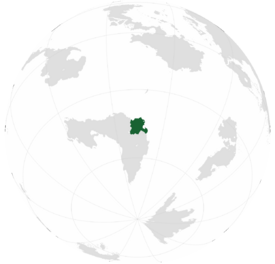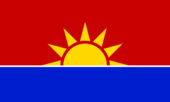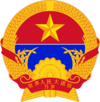Buyo
This article is incomplete because it is pending further input from participants, or it is a work-in-progress by one author. Please comment on this article's talk page to share your input, comments and questions. Note: To contribute to this article, you may need to seek help from the author(s) of this page. |
Buyonese Federative Socialist Republic 扶余联邦社会主义共和国 (Mandarin) | |
|---|---|
| Motto: 世界人民大团结万岁! Shìjiè rénmín dà tuánjié wànsuì! "Long live the unity of the world's people!" | |
| Anthem: 国际歌 Guójìgē "The Internationale" | |
 Location of Buyo | |
| Capital | Gemun |
| Largest city | Mokpo |
| Official languages | Mandarin |
| Recognised national languages | Congka Hulun Jusin Tamun Varasani Velnye |
| Recognised regional languages | Over 50 languages |
| Ethnic groups (2019) | 21.4% Tamun 20.1% Jusin 13.2% Shun 12.9% Varasani 11.4% Cong 9.7% Kusinye 7.6% Hulun 3.7% Other |
| Demonym(s) | Buyonese |
| Government | Federal one-party socialist republic |
• BPWP General Secretary President | Ilyiparise Alborz |
• Vice President | To Yun'o |
• Premier | Shen Kaizhi |
• Chairman of the People's Assembly | Sohon Ulhicun |
| Legislature | People's Assembly |
| Establishment | |
| 321 | |
| 472 | |
| 893-1178 | |
| 5 July 1321 | |
| 24 April 1644 | |
| 9 May 1917 - 17 November 1929 | |
• Current constitution | 15 June 1969 |
| Area | |
• Total | 1,181,881 km2 (456,327 sq mi) |
| Population | |
• 2026 estimate | 88,000,000 |
• 2019 census | 85,646,492 |
• Density | 72.46/km2 (187.7/sq mi) |
| GDP (PPP) | 2025 estimate |
• Total | 1.12 trillion Rovas |
• Per capita | 12,727 Rovas |
| GDP (nominal) | 2025 estimate |
• Total | 449.605 billion Rovas |
• Per capita | 5,818 Rovas |
| Gini (2025) | 32.6 medium |
| HDI (2025) | very high |
| Currency | Fiat (BYY) |
| Date format | dd-mm-yyyy |
| Driving side | right |
| Calling code | +29 |
| ISO 3166 code | BYO |
| Internet TLD | .by |
Buyo (Mandarin: 夫余; pinyin: Fūyú; Jusin: 부여; pyongum: Buyŏ), officially the Buyonese Federative Socialist Republic (BFSR) is a country in central Narushia. It is situated at the easternmost region of central Narushia, and bordered entirely by the Usnean Ocean. Buyo has a land area of 1.18 million square kilometers (456,327 square miles), with a population of approximately 88 million distributed over 15 provinces and two municipalities. The capital and second most populous city is Gemun, while the most populous city is Mokpo.
The region that now comprises Buyo has been inhabited since the Paleolithic era, with settlement focused around the Paemul and Tamun Rivers. The first organized states arose by the 6th century BCE, with the first written records dating to the 4th century BCE. Buyo's first real dynasty emerged in 121 CE with the Kyerim Kingdom. Following a civil war, the Faridunid Kingdom (472-893) took power, seeing the emergence of classical Buyonese cultures. Under the succeeding Yaksa Kingdom (893-1178) continued this cultural expansion, adopting the Varasani and Tamun scripts. The Mu Dynasty saw the formation of Buyo as a coherent state, while the Wen-Sohon Dynasty conquered to its largest extent. The Empire of Buyo was overthrown in the Buyonese Revolution, culminating in the establishment of the current Buyonese Federative Socialist Republic in 1929, under the Buyonese Peasants' and Workers' Party (BPWP). Early communist rule saw the dual industrialization of the country and sociocultural revolution, culminating in the 1969 Constitution, lessening the role of the BPWP in state affairs.
Buyo is a multiethnic country with over 65 recognized ethnic groups, with no dominant ethnicity. A shared identity has been formed around a shared ideology, defined by a national language, cultural diversity, and a common history. Buyo ranks highly in measures of ethnic equality.
Buyo is a federal one-party socialist republic constitutionally led by the BPWP. It is a member of the X, Y, and Z organizations. Buyo maintains an authoritarian regime where political opposition is not permitted. It is regarded as one of the worst countries in the world for independent journalism. Currently, the Buyonese economy is growing at a rapid pace, although it still remains a developing country. It maintains a largely planned economy, save for special economic zones in Mokpo, Isun, and Muksu.
Etymology
The term "Buyo" is believed to have originated from from Fu Yue (Mandarin: 傅说; pinyin: Fù Yuè), the legendary founder of the Mu clan that would later form the Mu Dynasty of the Buyonese Empire. Fu Yue was described as the son of Hapaek, the god of the Paemul River, who established the the modern-day city of Ryongyon, from which the Mus ruled.

